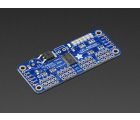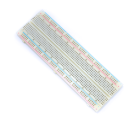3.3V Step-Up/Step-Down Voltage Regulator S9V11F3S5
Available with a lead time
Expect dispatch between Jan 22 and Jan 27
Quantity Discounts:
- 10-25 $12.00 (exc GST)
- 25+ $11.63 (exc GST)
 |
The S9V11x family of efficient switching regulators (also called switched-mode power supplies (SMPS) or DC-to-DC converters) use a buck-boost topology to convert both higher and lower input voltages to a regulated output voltage. They take input voltages from 2 V to 16 V and increase or decrease them as necessary, offering a typical efficiency of over 85% and a typical output current of up to 1.5 A. The flexibility in input voltage offered by this family of regulators is especially well-suited for battery-powered applications in which the battery voltage begins above the regulated voltage and drops below as the battery discharges. Without the typical restriction on the battery voltage staying above the required voltage throughout its life, new battery packs and form factors can be considered.
The different members of this family offer different output voltage options, from fixed voltages with selectable alternatives to adjustable voltages that can be set anywhere between 2.5 V and 9 V using a precision 11-turn potentiometer. Some versions also have an adjustable low-voltage cutoff that can be set anywhere in the 2 V to 16 V output voltage range and used to prevent your battery from over-discharging. This is particularly useful for battery chemistries that can be damaged when over-discharged, including Li-ion and LiPo. The chart below lists all the regulators in the S9V11x family along with the key features of each version:
 | 2.5 V – 9 V (fine-adjust) | |
 | 3.3 V (5 V selectable) | fine-adjust |
 | 3.3 V (5 V selectable) | 3 V (fixed) |
 |
 |
Step up/step down regulator S9V11F3S5 on a breadboard. |
|---|
These regulators have short-circuit protection, and thermal shutdown prevents damage from overheating; they do not have reverse-voltage protection. Note that the startup current is limited to approximately 700 mA until the output voltage reaches the nominal voltage; after startup, the available current is a function of the input voltage (see the Typical efficiency and output current section below).
Details for item #2872
Features
- Input voltage: 2 V to 16 V (note: this regulator requires 3 V to start, but it can operate down to 2 V after startup)
- Fixed 3.3 V output with +5/-3% accuracy (can be changed to 5 V using the SEL pin)
- Typical maximum continuous output current: 1.5 A (when input voltage is close to the output; the Typical efficiency and output current section below shows how the achievable continuous output current depends on the input and output voltages)
- Power-good indicator can be used to tell when the regulator has reached and is maintaining its target output voltage
- Power-saving feature maintains high efficiency at low currents (quiescent current is less than 1 mA while enabled and approximately 7 µA per volt on VIN when regulator is disabled)
- Integrated over-temperature and short-circuit protection
- Small size: 0.5" × 0.6" × 0.17" (12.7 × 15.3 × 4.3 mm)
Using the Regulator
During normal operation, this product can get hot enough to burn you. Take care when handling this product or other components connected to it.
Connections
The step-up/step-down regulator has five main connections all located along the same edge of the board: the output voltage (OUT), ground (GND), the input voltage (IN), an enable input (EN), and a power good indicator (PG). A sixth pin, SEL, can optionally be used to change the output voltage from 3.3 V to 5 V.
 |
The output voltage, VOUT, defaults to 3.3 V but can be changed to 5 V with output voltage selection pin whose operation is described below.
The input voltage, VIN, should be between 3 V and 16 V when the regulator is first powered. After it is running, it can continue operating down to 2 V. Lower inputs can shut down the voltage regulator; higher inputs can destroy the regulator, so you should ensure that noise on your input is not excessive, and you should be wary of destructive LC spikes (see below for more information).
The regulator, which is enabled by default, can be put into a low-power sleep state by reducing the voltage on the EN below 0.7 V, and it can be brought out of this state again by increasing the voltage on EN past 0.8 V. The quiescent current draw in this sleep mode is dominated by the current in the 100 kO pull-up resistor from ENABLE to VIN, which is approximately 10 µA per volt on VIN (e.g. approximately 30 µA with 3 V in). The tight tolerance of the enable input allows a precise low-VIN cutoff to be set, such as with the output of an external voltage divider powered by VIN, which is useful for battery powered applications where draining the battery below a particular voltage threshold could permanently damage it.
The “power good” indicator, PG, is an open-drain output that goes low when the regulator’s output falls below around 90% of the nominal voltage, including when the enable pin is held low. The power good indicator is held low until the output reaches 95% of the nominal voltage when it is powering up or coming out of low-power mode. Otherwise, the PG pin is high-impedance, so an external pull-up resistor is required to use this pin.
The select input, SEL, can be driven above 1.1 V (up to 16 V) to change the output voltage of the regulator to 5 V. Driving the pin low or leaving it disconnected sets the output to 3.3 V. To permanently set the output to 5 V, you can solder a piece of wire between SEL and the unpopulated pad next to it, which is pulled up to VIN; the following picture shows an example of this:
 |
Included hardware
 |
The five main through-holes are arranged with a 0.1" spacing along the edge of the board for compatibility with standard solderless breadboards and perfboards and connectors that use a 0.1" grid. You can solder wires directly to the board or solder in pieces of the included breakaway 6×1 straight male header strip or the 5×1 right-angle male header strip as desired. The additional straight male header pin can be soldered into the SEL input, though this could prevent the regulator from being used in a breadboard.
Typical efficiency and output current
The efficiency of a voltage regulator, defined as (Power out)/(Power in), is an important measure of its performance, especially when battery life or heat are concerns. As shown in the graphs below, this family of switching regulators typically has an efficiency of 85% to 95%. A power-saving feature maintains these high efficiencies even when the regulator current is very low.
The maximum achievable output current of these regulators varies with the input voltage but also depends on other factors, including the ambient temperature, air flow, and heat sinking. The graph below shows maximum output currents that these regulators can deliver continuously at room temperature in still air and without additional heat sinking. Depending on the input and output voltage, these regulators can temporarily deliver over 2 A, though they will typically quickly overheat under such conditions and go into thermal shutdown.
 |
Note that the startup current for input voltages above the regulated output voltage is limited to approximately 700 mA, and currents in excess of this are only available after the output has finished stabilizing. For input voltages below the output voltage, the available start up current decreases linearly with the input voltage to approximately 0.3 A with an input of 3 V. Large capacitive loads will generally not pose a problem because they will gradually charge up even with the current limit active, so while they may increase the time it takes an S9V11x family regulator to start up, the regulator should still eventually stabilize. A purely resistive load, however, could prevent the regulator from ever reaching the desired output voltage. For example, if the output of the regulator is 5V and you put a 5 O resistor between VOUT and GND and then apply power to the regulator, the output voltage will never rise past 3.5 V, the voltage at which the current draw reaches the 700 mA limit. As such, this family of regulators is intended for applications like robotics, where any large loads are controllable and can be applied only after the regulator has finished starting up.
LC Voltage Spikes
When connecting voltage to electronic circuits, the initial rush of current can cause voltage spikes that are much higher than the input voltage. If these spikes exceed a regulator’s maximum voltage, the regulator can be destroyed. If you are connecting more than about 9 V, using power leads more than a few inches long, or using a power supply with high inductance, Pololu recommend soldering a 33 µF or larger electrolytic capacitor close to the regulator between VIN and GND. The capacitor should be rated for at least 20 V.
More information about LC spikes can be found in Pololu's application note, Understanding Destructive LC Voltage Spikes.
People often buy this product together with:
 | Pololu 3.3V Step-Up/Step-Down Voltage Regulator S7V8F3 |
 | 2.5-9V Fine-Adjust Step-Up/Step-Down Voltage Regulator w/ Adjustable Low-Voltage Cutoff S9V11MACMA |
 | 2.5-9V Fine-Adjust Step-Up/Step-Down Voltage Regulator S9V11MA |
Dimensions
| Size: | 0.5" × 0.6" × 0.17"1 |
|---|---|
| Weight: | 0.7 g1 |
General specifications
| Minimum operating voltage: | 2 V2 |
|---|---|
| Maximum operating voltage: | 16 V |
| Maximum output current: | 1.5 A3 |
| Output voltage: | 3.3 V4 |
| Reverse voltage protection?: | N |
| Maximum quiescent current: | 1 mA5 |
Identifying markings
| PCB dev codes: | reg20b |
|---|---|
| Other PCB markings: | 0J10534 |
Notes:
- 1
- Without included optional headers.
- 2
- Note: the minimum startup voltage is 3V, but the regulator can operate down to 2V after startup.
- 3
- Under typical conditions, where the input voltage is close to the output voltage. Maximum output current can be higher when stepping down and lower when stepping up.
- 4
- Output can be changed to 5 V by driving the SEL pin over 1.1 V.
- 5
- With no load. Actual quiescent current depends on input voltage; it is typically under 300 µA when the input voltage is close to the output voltage.
File downloads
-
Dimension diagram for the Step-Up/Step-Down Voltage Regulator S9V11x (142k pdf)
Note: this dimension diagram does not apply to the smaller S9V11F5.
-
3D model of the Step-Up/Step-Down Voltage Regulator S9V11x (4MB step)
Note: this model does not apply to the smaller S9V11F5.
-
Drill guide for the Step-Up/Step-Down Voltage Regulator S9V11x (23k dxf)
This DXF drawing shows the locations of all of the board’s holes. Note that this does not apply to the smaller S9V11F5.
Exact shipping can be calculated on the view cart page (no login required).
Products that weigh more than 0.5 KG may cost more than what's shown (for example, test equipment, machines, >500mL liquids, etc).
We deliver Australia-wide with these options (depends on the final destination - you can get a quote on the view cart page):
- $3+ for Stamped Mail (typically 10+ business days, not tracked, only available on selected small items)
- $7+ for Standard Post (typically 6+ business days, tracked)
- $11+ for Express Post (typically 2+ business days, tracked)
- Pickup - Free! Only available to customers who live in the Newcastle region (must order online and only pickup after we email to notify you the order is ready). Orders placed after 2PM may not be ready until the following business day.
Non-metro addresses in WA, NT, SA & TAS can take 2+ days in addition to the above information.
Some batteries (such as LiPo) can't be shipped by Air. During checkout, Express Post and International Methods will not be an option if you have that type of battery in your shopping cart.
International Orders - the following rates are for New Zealand and will vary for other countries:
- $12+ for Pack and Track (3+ days, tracked)
- $16+ for Express International (2-5 days, tracked)
If you order lots of gear, the postage amount will increase based on the weight of your order.
Our physical address (here's a PDF which includes other key business details):
Unit 18, 132 Garden Grove Parade
Adamstown
NSW, 2289
Australia
Take a look at our customer service page if you have other questions such as "do we do purchase orders" (yes!) or "are prices GST inclusive" (yes they are!). We're here to help - get in touch with us to talk shop.
Have a product question? We're here to help!
Guides
The Maker Revolution
Projects
3D Printed Pico Weather Display
RGB Light-Up Remote-Control Car
Pi Zero Motion Sensing Camera
Makers love reviews as much as you do, please follow this link to review the products you have purchased.























Product Comments